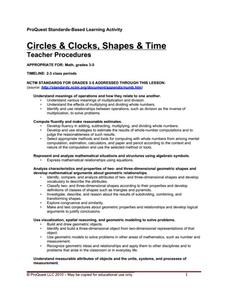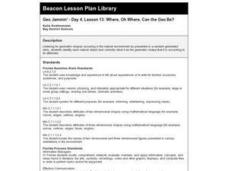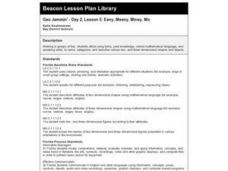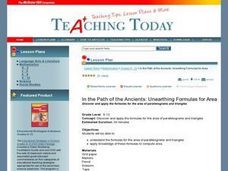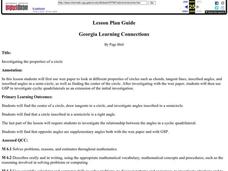Curated OER
Circles and Clocks, Shapes and Time
Students work in groups to research clocks and practice telling time. In this telling time lesson plan, students use the computer program ProQuest to study circles, including radius and diameter, and practice drawing circles using a...
Alabama Learning Exchange
Is It a Triangle?
Students explore the concept of triangle inequalities. In this triangle inequality lesson plan, students cut spaghetti noodles into given lengths. Students use the noodles to complete a worksheet about triangle inequalities. Students...
Alabama Learning Exchange
Trapezoids: What's Equal or Right About Them?
Pupils explore the concept of trapezoids. In this trapezoids instructional activity, students identify legs and bases of a trapezoid. Pupils discuss the similarities and differences between isosceles trapezoids and right trapezoids. ...
Curated OER
Pythagorean Theorem Investigation
Eighth graders investigate the Pythagorean Theorem and practice applying the theorem to various triangles. Finally, in the next lesson in the sequence, 8th graders create a song or a story to help them remember the Pythagorean Theorem.
Curated OER
Looking at Still Life Lesson 2: How Artists Assemble Still Lifes
Students identify and discuss the basic shapes used in artistic still-life compositions.
Curated OER
Geo Jammin' - Day 4, Lesson 13: Where, Oh Where, Can the Geo Be?
Learners listen to a story "My Crazy Dream" with an intent to identify shapes in ordinary objects. They raise their hands when they've heard an object whose shape they can identify. They discuss their findings.
Curated OER
Geo Jammin' - Day 2, Lesson 5: Eeny, Meeny, Miney, Mo
Learners, in groups, use song lyrics and math to descrie two and three dimensional shapes.
Curated OER
Pythagorean Theorem Proof
Tenth graders investigate the Pythagorean Theorem. Then they type up a formal paragraph proof of a proof of their choice.
Curated OER
Triangle Explorer
Students calculate the area of triangles using a variety of materials including computer applets.
Curated OER
Follow The Falling Meteorite
Students investigate the supposed traveling path of a meteorite. They use sound in order to triangulate the path. The results of the experiment are written on a map to display the path of the meteorite. The culminating activity is when...
Curated OER
In the Path of the Ancients: Unearthing Formulas for Area
Students apply the formulas for the area of parallelograms and triangles. Through guided practice, students discover the correct way to apply the formulas. Working in pairs, they write their own problems featuring the formulas.
Curated OER
Fractions of a Set
Third graders use fractions to describe part of a set. In this fractions lesson, 3rd graders are introduced to fractions through a book and use pattern blocks to describe a fraction as a part of a set. This lesson includes a scripted...
Pennsylvania Department of Education
Introducing the Coordinate Plane
Fifth graders practice using estimation. In this estimation instructional activity, 5th graders add, subtract, multiple, and divide using whole numbers, fractions, and decimals. Students decide upon instances when estimation is more...
Curated OER
Investigating the properties of a circle
Students use wax paper to look at different properties of circles such as chords, tangent lines, inscribed angles, and inscribed angles in a semi-circle, as well as finding the center of the circle, and use GSP to investigate cyclic...
Curated OER
Geo Jammin'-Day2, Lesson 7: Roll, Roll, Unroll the Scroll
Second graders write in journals, recording personal thoughts about what they learned and/or something they are wondering about.
Curated OER
Area Lesson Plan
Students manipulate a variety of materials and computer applets in order to explore area and the units used to measure it.
Curated OER
"Kookie Kitties" - Paul Klee: Finger Puppets
Young scholars examine and discuss the painting, Cat and Bird, by Paul Klee. They identify the various types of lines, shapes, and colors in the painting, and design and create finger puppet versions of the animals from the painting.
Curated OER
Discovering Solids
Second graders engage in a lesson that is about the discovery of solids. They identify using shapes like cones, spheres, cylinders, and cubes in various different situations. Students explore the classroom in order to find examples of...
Curated OER
Relationships and Functions
Fifth graders describe patterns as relations and functions. In this patterning lesson, 5th graders analyze and continue patterns. Students understand how patterns relate to relations and functions.
Curated OER
Jell-O Optics
Learners observe an activity with Jell-O to learn about optics. In this investigative lesson students fill out a handout on the activity that helps them to investigate the index of refraction and the speed of light.
Curated OER
Paulo Coehlo's The Alchemist
In the allegory worksheet students analyze Paulo Coelho's novel, The Alchemist. Students analyze allegorical elements by answering guided questions.
Curated OER
Pattern Using Unit Cells
Students explore the pattern of the unit cell. In this science lesson, students color the unit cells on a worksheet and create a pattern using unit cells.
Curated OER
3-D Figures Part 2
Young scholars work with three dimensional objects. In this geometry instructional activity, students examine models of spheres, cones, cubes, prisms, and pyramids, and identify them by their edges, vertices, and faces.


